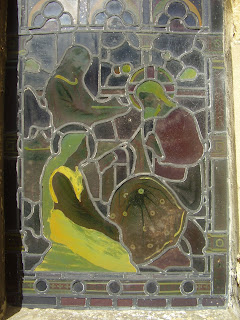David Overton, a local musician, has set my words from the Orumulum (posted here on 6th January 2010) as an anthem, which the choir at Grimsby Minister sang for the first time at a mid-week Evensong before Christmas. It has a lovely mediaeval feeling lilt to it. David’s father was Organist at St Michael’s for many years and I remember visiting him in his Abbeyfield House room soon after I arrived here. David’s own credits include arranging music for James Galway, and he is himself a member of the Minster’s choir.
Meanwhile, I have got about half way through my project of re-telling the three dozen or so poems of Earl Rognvaldr from the Orkneyinga Saga (begun with the Grimsby poem posted here on 11th September 2011).
For example, Prof Judith Jesch’s literal “Here I’ve raised a high cairn to a strong minded ghost in dark Dollsteinshola; in this way I look for rings - I do not know who among the pushers of wave-skis [a kenning for sailors] will go later the long and ugly way, the route across the broad lake” has become
We pile up stones to mask our fear
and keep the cave’s strong ghouls awaywho in the deep of Doll’s dark hole
maintain their grip on rings of gold.
We pile up stones to mark our feat:
perhaps some men will skim the sea
and then on this our awful route
will find our cairn already built.
Her “I hang a snake of the bridge of the hawk [a kenning for arm-ring built on a kenning for arm] made round by the hammer on the gallows of the tongs [another kenning for arm]; we reveal the drink of Grimnir of hanged ones [a kenning for poetry built on a kenning for Odin] - The fir-tree of the gleaming-voice of the Gautar of the cave [a kenning for women built on a kenning for gold built in turn on a kenning for giants] has gladdened me so much that I play with my hollows of the backward-bending feller of the lagoon [a kenning for oar built on a kenning for hand]” has become
Hands which swung felled-trees through water
stroke the gold that snakes in loops
where the hunter’s hawk last rested,
stroke the gold once executed
by such hammer wielding hands.
Drink with me, great God of all fate,
sing of one tree-tall-slender,
sing of her bright treasure-bearing,
delight with me at all her splendour,
sing, and to her beauty drink.
And her “Einarr said that he wished to entertain none of the followers of Rognvald except the jarl himself; the roaring sea of Gauter [a kenning for poetry] comes to my palate – I know that [the one] not amiable to men overturned his promises; I went in where the fires of Yggr [a kenning for swords] burned late in the evening” has become
In my speech the storm surge sings
of Einar set to lure me in
at whose farm the forge fire flames
with burning swords and twisting claims.

















































